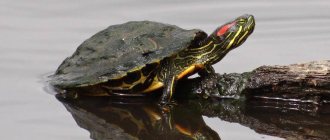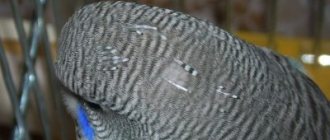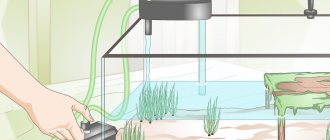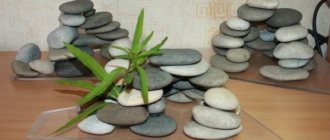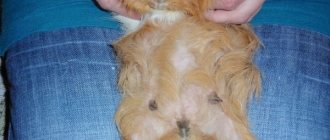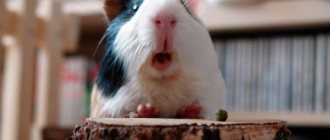Molting time for red-eared turtles
Do not be alarmed when the red-eared slider begins the molting process. This is a natural process that occurs in a young individual during a period of active growth. The reptile grows quite quickly and the shell simply cannot keep up with its growth. Therefore, all or part of the shell peels off. This process is absolutely safe for the turtle, but during this period it needs special care.
A turtle in the early stages of its development may experience complete peeling of the top layer of its shell. As the turtle matures, the amount of dead tissue decreases. This is no longer the entire upper layer of the reptile’s shell, but only part of it. After some time, the red-eared slider's molting stops.
How not to get confused?
Many turtle owners consult a veterinarian when they begin to shed. And this is not surprising, since many diseases have symptoms similar to molting processes. Such diseases include: fungus, which can result in parts of the skin peeling off, rickets, which leads to curvature of the shell and, as a result, detachment of its parts. If your diet includes insufficient amounts of vitamins, this can also lead to flaking of the skin.
If it is difficult to determine the cause of peeling skin, it is better to contact a veterinarian, he will tell you exactly what the reason is. Unfortunately, this is not always possible; then you need to be guided by the following considerations. If peeling is detected, you should observe the pet's behavior. As a rule, most diseases are accompanied by general depression of the turtle’s body. If nothing has changed in the reptile’s behavior and it leads an active lifestyle, then most likely it is molting. In this case, there is reason to be in a good mood, since the reptile is growing and developing as it should be and there is no reason for concern.
If the turtle refused to eat and stopped behaving actively, then in any case, whether you want it or not, whether there is an opportunity or not, it is better to show the pet to the veterinarian. Ignoring this kind of behavior can lead to disastrous results, that is, you can lose the turtle. The appearance of any disease indicates that the animal has received little attention and is growing in conditions where there may be a lack of nutrition or sanitary conditions may be better. In this case, the attitude towards a living being needs to be changed towards improvement. First of all, you should decide on the diet and duration of receiving UV-van. Without these two components, it is unlikely that a small turtle will grow into an adult.
Features of caring for your pet during the molting period
During the molting period of your pet, special attention should be paid to its nutrition. There is no need to radically revise your diet or change your diet. It is enough to add products containing calcium and vitamins to it. To replenish the loss of these substances, it is recommended to give the turtle small fish or crustaceans. You can also buy food for young turtles in specialized stores.
Also during the molting period, it is important to monitor the cleanliness of the turtle’s home and the aquarium. The thing is that dying shell particles float on the surface, thereby polluting the water. Dirty water is a favorable environment for the development of bacteria. Therefore, you should change the water as often as possible or install a filter in the aquarium.
Some owners try to speed up the molting process of their turtle by forcibly removing the top layer of the shell. This is strongly not recommended. You can help remove a layer of shell if the turtle cannot do this on its own for a long time. A shell that does not peel off is uncomfortable for the turtle and can cause injury and poor health.
To speed up the molting process, you can gently wipe the shell with a decoction of chamomile flowers. You can remove the turtle from the aquarium for a while and let it dry completely. Dry scales will peel off more easily and fall off as the turtle crawls or swims in the aquarium.
During the molting period, experts advise bathing turtles to remove remaining dirt from under the shell scales and prevent them from rotting. For swimming you will need a small container with low sides. Fill it with warm water and add baking soda at the rate of 1 teaspoon per liter of water. Carefully lower the turtle into the container so that its head remains on the surface. After 20 minutes of taking a bath, take it out, carefully blot off excess water with a towel and apply a few drops of olive oil to the shell.
Signs of illness
The main symptomatic manifestations of turtle diseases:
- the animal stays on the surface of the water for a long time;
- swelling of the eyes, purulent discharge;
- weakness;
- loss of appetite;
- feces with blood;
- white coating;
- shell detachment;
- softness of the shell;
- foam at the mouth.
Another warning sign is a long stay at the bottom of a reservoir, although in some cases turtles may simply fall asleep at the bottom. This will not mean that she has any health problems, but she needs to be woken up and moved to another place, otherwise the animal may die.
If there are any signs of illness, the turtle should be shown to a specialist. Don't put off visiting your doctor.
Causes of fungus
What is most interesting is that in natural conditions turtles practically do not get sick from the fungus. Some experts believe that the reason for this is captivity, in which basic instincts may be dulled, as well as a decrease in the effectiveness of the immune system.
In addition, a fungus in a pet can develop against the background of diseases such as pneumonia, tympany, as well as other negative factors that reduce the resistance of the immune system. Plus, this can be caused by the conditions of detention, as well as a meager diet. A lack of various vitamins, as well as inconsistency in temperature conditions, can serve as the trigger that will give rise to the development of infectious diseases, including fungus.
Most experienced owners can predict the appearance of fungus in advance, especially during periods after recovery from acute respiratory infections or other ailments that had to be treated with antibiotics. In this case, they prepare in advance to prevent the occurrence of mycosis. If you do not carry out such activities, the disease will soon remind itself and then it will be very difficult to cope with it.
The following types of fungi should be noted:
- Aspergillus spp;
- Candida spp;
- Fusarium incornatum;
- Mucor spp;
- Panicillium spp;
- Paecilomyces lilacinus.
As a rule, a fungal infection thrives and actively multiplies in conditions of high humidity. When the water in the aquaterrarium warms up above +26°C, then there is a high probability of fungal infection, especially during the molting period, when the skin has minimal resistance, both mechanical and antiviral. In addition, at elevated water temperatures, the turtle spends a lot of time in the water without crawling onto land to warm up and dry out. Therefore, the temperature of the water should be maintained at +22°C-+26°C, and the temperature of the island +28°C-+32°C. Then the turtle will simply be drawn to the island to receive a certain dose of heat. Here it will dry out quickly and then the fungus is unlikely to be able to develop.
When arranging the habitat of the red-eared turtle, one should take into account such a thing as sufficient space for both living and rest. There should be enough space on the island for the turtle to feel comfortable and have the desire to constantly climb to this island. To make it convenient for her to do this, you should organize a smooth rise from the water. You should always remember that the reptile will grow up and it simply needs appropriate comfort. This indicates that you should not skimp on living space. You should always be aware of this, especially before purchasing a pet.
Prevention measures
Any disease is easier to prevent than to treat. Turtle shell problems are no exception. To avoid them, provide your reptile with adequate nutrition. The menu should consist of food of animal and plant origin.
Buy a UV lamp and give your turtle irradiation sessions to produce vitamin D in its body, which facilitates the absorption of calcium. In summer, take your turtle outside for walks. At the same time, make sure that the animal does not come into direct sunlight.
Pay attention to the water you fill the aquarium with. Its excessive rigidity can negatively affect the condition of the shell
This water must be filtered.
In addition, tap water contains chlorine, which causes certain diseases. Let it sit for a day before pouring it into the aquarium so that the harmful impurity has time to evaporate.
Redness and swelling of the eyes
As a rule, such diseases occur due to poor turtle hygiene. Eye diseases are called ophthalmological. Symptoms are: the eyes may become swollen and cannot open, the eyelid is swollen and may stick together, the turtle cannot open the eyes, redness of the mucous membrane, a film on the eye, clouding of the cornea, loss of vision, fear of bright light, intense lacrimation, discharge from the eyes, decreased activity of the animal . The likelihood of ophthalmology occurs when the body is weakened after another illness.
When a disease is detected, it is important not to self-medicate, but to consult a doctor who will select the appropriate course. There are many eye diseases in water turtles, and they are easy to confuse - only a specialist will be able to determine exactly what needs to be done to ensure good health
Detailed instructions for the owner of a molting turtle
Pets raised outside the wild are dependent on their owners and have a harder time going through natural processes. It is important for reptile owners to follow recommendations to facilitate the molting process and avoid possible troubles.
- Fortify your diet
. The turtle needs calcium to grow, so feed it small crustaceans and small fish straight from the bones, which can be easily crushed by the turtle's strong jaws. Be sure to consult your veterinarian regarding vitamins to avoid overdose. - Moisturize your skin
. Lubricate the rags on the paws and neck with a non-greasy cream or lavender balm, sold at the pharmacy. Remember not to lubricate the shell or use the cream for more than 5 days in a row. On day 6, take a break and apply the cream with a break of 1 day. - Have a swim
. When the scales on the turtle's shell come off, dirt containing pathogenic microorganisms gets trapped under them. You can bathe your pet no more than 2 times per molt. For this:- Buy a small container with a low side to prevent the turtle from being completely submerged.
- Fill it with warm water and dissolve baking soda in it (1 teaspoon of soda per 1 liter of water).
- Place the reptile in the water, leaving its head on the surface to breathe.
- wait 20 minutes and take your pet outside.
- wait until the shell dries and blot off any remaining moisture with a soft cloth.
Keep the terrarium clean
. If the skin of a red-eared turtle peels off, then its particles contaminate the water and start the process of decay. Pathogenic microflora increases the risk of viral infection, so it is important to promptly remove pieces of peeling skin and take care of high-quality filtration.
IMPORTANT! Do not use oils or balms to lubricate the shell. They fill the pores, causing disruption of air exchange and the development of fungus. Oily products are only suitable for moisturizing the skin.
. Speed up the molting of your red-eared turtle by smearing its shell with chamomile infusion. The smeared scales quickly dry out in the open air and fall off on their own without additional help.
. Help is needed if the dead skin does not come off for a long time, and the pet injures itself in attempts to get rid of it. When removing, follow these steps:
- Use a soft-bristled toothbrush. Stiff bristles can injure and frighten your reptile.
Gently clean off the thin plates of the shell using light massage movements.
Perform all actions smoothly, avoiding excessive pressure. IMPORTANT! White stains on a turtle's shell caused by hard water can be removed with lemon juice. To avoid a recurrence of the situation, use water that has passed through filters.
Fungus treatment
It is quite easy to rid a turtle of a whole “bouquet” of infectious diseases if you follow the appropriate recommendations.
- Since there are several types of microbiotics for fungal infections, only a specialist can determine an accurate diagnosis. To do this, you will have to take a blood test and a smear. Only based on the test results can a conclusion be made about the type of fungal disease.
- Regardless of what kind of fungus the turtle has, it is necessary to completely disinfect the aquaterrarium, as well as the objects inside it.
- If several individuals are kept, the sick turtle is removed until the disease disappears. The turtle can be cured in two weeks or 2 months, depending on the severity of the disease.
- You need to add Methylene Blue to the water. Its quantity is selected so that the water is slightly colored and has a slightly bluish tint. If the aquaterrarium has a carbon filter, then it is better to turn it off, otherwise the effect of the drug will be neutralized.
- A sick turtle undergoes preventive and therapeutic actions. To do this, it is placed in a bath with oak bark tincture for 1 hour. This procedure is carried out daily until the fungus completely disappears. The color of the liquid should match the shade of regular tea. In severe cases, the concentration of oak bark can be increased.
- The turtle should be irradiated daily with a UV lamp. This radiation (ultraviolet) can destroy the infection.
- In addition to the above measures, the use of ointments is required. Ointments such as Triderm, Terbinofin, Akriderm and Nizoral are suitable for this. The turtle is smeared overnight, leaving it in a dry, warm place.
- In parallel with the treatment procedures, the sick turtle is prescribed a diet rich in vitamins and nutrients.
As a rule, such instructions refer to the main treatment regimen, although treatment with other methods is also possible. In any case, it is better to consult a veterinarian and not start self-treatment, which can lead to unpredictable consequences.
If the vet is out of reach...
Fungus
Having noticed that the turtle has begun to molt, the owner should examine it and observe carefully. If, in addition to detachment, no other deviations from the norm are identified, the animal behaves actively, there is no reason for concern.
Having discovered that the shell is peeling off very much and even crumbling, you should resort to special treatment, which is prescribed based on the diagnosis. (The symptoms of various “shell troubles” were discussed above).
Pharmacies sell antifungal drugs Nizoral or Lamisil. They should be used to lubricate the damaged areas of the shell at night for two weeks, having first very carefully cleaned off the exfoliated tissue.
The fungus can cause irreversible degeneration in the tissues of the turtle “armor”. Such tissues must be carefully cleaned and BetaisodonaR ointment applied to the ulcerated area.
In the case of a fungal disease, “therapeutic baths” are recommended for the amphibian - bathing in chamomile decoction, a weak solution of potassium permanganate or malachite greens. The latter, by the way, is used to disinfect aquarium water.
The disease in its unadvanced stage can be treated quite successfully. If the fungus reaches the internal organs, it can cause the death of the animal.
The shell of a land turtle can peel off as a result of dehydration. In this case, daily bathing of the animal is recommended.
As for rickets, which, as we found out, is the result of a deficiency of vitamin D and calcium, here we are most likely talking not so much about the treatment of the disease, but about its prevention.
In the autumn-winter period, turn on the UV lamp.
So, in the warm season, it is recommended to take the aquaterrarium with the turtle out into the fresh air, while protecting the reptile from direct rays of the daylight.
In the autumn-winter period, the dwelling with the amphibian must be placed under a UV lamp three times a week - literally for five minutes.
Before the procedure, it is recommended to cover the turtle’s eyes with a plaster so as not to harm the lens and retina.
To replenish the level of calcium in the reptile’s body, shrimp rich in this element will not be superfluous in its menu. Since this pleasure is not cheap, you can treat your pet with fish and bones instead. Bone meal, crushed egg shells, and chalk are very useful.
If the disease is advanced, the veterinarian, as already mentioned, will prescribe vitamin injections.
Therapeutic measures
Treatment of fungal pathology is quite simple if the necessary measures are taken on time.
Disinfecting the turtle’s entire house, as well as objects with which it has come into contact, will help to cure mycosis in a timely manner. If you have not one animal, but several, then treatment begins with separating the sick animal from the healthy ones. This is done for the entire recovery period so that healthy individuals cannot get sick. Treatment involves the use of disinfectant solutions; methylene blue is well suited for this. How to treat a reptile with it? Everything is very simple, it is added to the aquarium until the water turns a soft blue color. Your animal should stay there all day. If you find a working carbon filter, it is better to turn it off, as it will remove all this solution.
Prepare an oak bark tincture; its color should be similar to tea. Oak bark has a good antiseptic and healing effect. Such oak tincture baths are carried out daily. The turtle should be placed in this liquid for forty to fifty minutes.
The ultraviolet lamp must work around the clock. Its rays have a detrimental effect on most microorganisms, including fungi.
Treatment with antifungal ointments is mandatory. It is better to use ointments recommended by a specialist. They are applied at night, and the turtle must remain on dry land until the morning.
It is necessary to strengthen the animal’s nutrition and balance it. Give a lot more vitamin and mineral supplements and protein.

